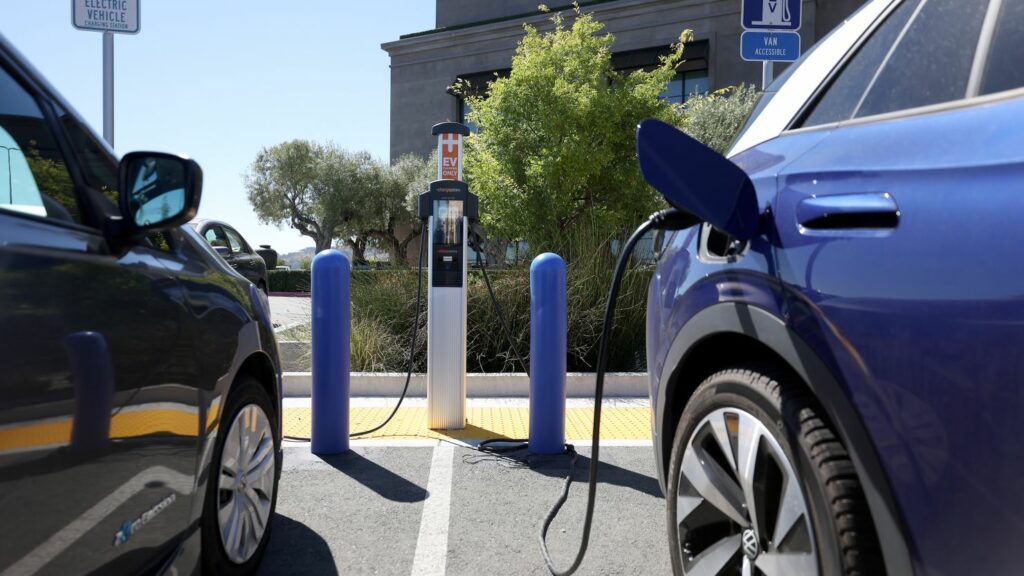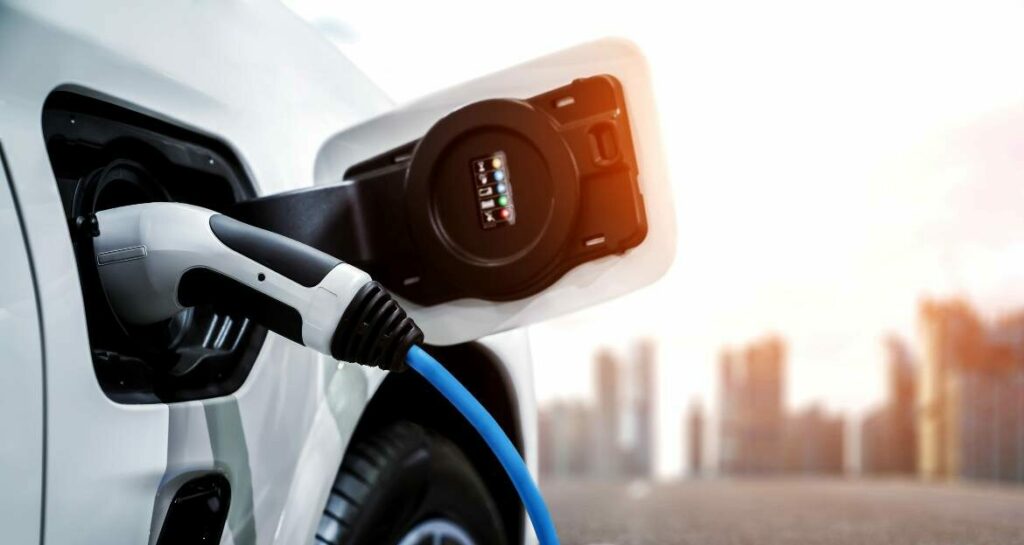The vaunted EV industry, vaunted here being a term meaning favoured by politicians not customers or companies, continues to crash. For instance “Ferrari halves targets for electric cars amid falling demand”. And if the Ferrari crowd can’t afford them it’s a bigger sign of trouble even than when Ford did it two years ago. And GM is now following suit. Zealots may continue to push the pedal and make “voom voom” noises. But the thing’s just not moving.
According to The Telegraph, those retrograde actual people want cars that work. And so “Italian marque will double number of traditional combustion engine models as it delays EV plans”. Delays. Yeah. Until the Second Coming of Greta Thunberg or some such.
Meanwhile over at the working person’s car company, Robert Bryce observes:
“On Monday, Ford announced its first-quarter results, which include EBIT (earnings before interest and taxes) of $1 billion. Those results would have been far better had it not lost $849 million on its Model E segment. Ford sold 22,550 EVs in the first quarter. That means it lost about $37,650 for each EV sold.”
You do not have to be an entrepreneurial genius or even a professor of management to grasp that losing that much per EV is not what took Henry Ford from a tinkerer to a titan of industry.
It’s a reality thing. Thus David Blackmon observes pointedly:
“In a stark admission that the electric vehicle revolution is more mirage than reality, Colorado’s Regional Transportation District (RTD) is set to borrow a whopping $539 million to replenish its bus fleet, effectively shelving its longheld EV bus dreams. This move, detailed in RTD’s latest financial forecast, underscores the harsh lessons learned from pushing unripe green tech onto public transit systems: it doesn’t work, it costs a fortune, and taxpayers foot the bill for the fallout.”
Oh darn. At some point even the last bit, where someone else is paying for your blunder, hurts you.
So does economic ignorance. Bloomberg Green recently tried to peddle as good news “The Fastest-Selling Cars in America Are Used EVs”. But it just won’t wash, because the first guy they profile spotted something they didn’t:
“A year ago, the new Ford Mustang Mach-E GT had a sticker price around $55,000. A month ago, Jeff Craig, a retired realtor, bought a slightly used 2024 version for $33,000. In exchange for 12 months and 13,000 miles, Craig got a 22% discount. ‘I really did want an electric vehicle and I never had any intention of buying new,’ he said. ‘And I know what the depreciation is on any new vehicle, but I also had noticed the depreciation on the EVs appeared to be considerably more than a gas engine.’”
Indeed. Why so? What is this rapid depreciation all about? Why, buyer’s remorse. The painful recognition that it was worth so much less than you paid, even with a subsidy, that you’re better off dumping the thing at a sizeable loss. After conceding that “new EV sales in the US are expected to slow drastically when federal purchase incentives up to $7,500 disappear at the end of the month” of September, the article added:
“prices of used EVs have steadily ticked down, a byproduct of more mainstream, non-luxury models and steep depreciation rates. Electric vehicles shed their value quickly, largely because consumers expect the technology to improve quickly.”
Um no. That last part is totally wrong. They shed their value quickly not because of what someone else thinks of a different car that doesn’t exist yet but because of what the current owner thinks of this one. Which is why a used EV two to three years old is competitive with a used gas-powered vehicle six to seven years old even if the Bloomberg Green writer thinks it means the opposite of what it actually means. Including this prattle:
“There’s also evidence that electric vehicles may prove to be more reliable over time than gas-powered machines.”
If so it would make them more valuable, not less, and reduce depreciation. Take an ECON 101 course, dude. And a follow-up on public choice theory if you think a press release “CEOS Urge Ottawa to Stay the Course on Canada’s EV Standard” is anything other than “Dozens of senior executives from across Canada’s electric vehicle (EV) ecosystem” signing a letter to the PM saying please do not empty our trough.
The same author contributed a follow-up “EVs are no longer niche” about how:
“Americans bought 438,500 electric cars and trucks in the third quarter… Those transactions, the highest number in a single quarter, comprised 11% of all new car sales, eclipsing the previous high point of 8.7%, according to Cox Automotive, a services and technology company... A crowd of more affordable cars next year could help maintain the momentum, but analysts expect EV transactions to dip in the months ahead without federal tax credits.”
Incredible. But why shouldn’t journalists be addled on such matters when a surprising number of business executives are too.
Many Ford executives are still determined to bankrupt what’s left of his empire even after a string of bad decisions from the 1970s on by the firm and by unions unable to grasp the parable of the golden goose. And possibly part of the problem is that American automakers were slow to react to the “energy crisis” of the 1970s and don’t want to make what feels like the same mistake with the “climate crisis”.
So electric cars having bombed, they’re plunging into electric trucks. The big bet on switching a Louisville plant “which, after producing gas-powered vehicles for 70 years, will be converted to manufacture electric vehicles” is meant to be getting back to their roots according to Canada’s CBC state propaganda outlet:
“The automaker sees this as a ‘Model T moment’ for its EV business - a reference to revolutionary changes on the production line led by the company’s founder, Henry Ford, when it began churning out vehicles from a factory more than a century ago. [Ford CEO Jim] Farley said the changes will upend how electric vehicles are made in the U.S.”
Which is a rear-door admission that it had better because when you’re losing $37,650 per EV not even the $7,500 subsidy now being phased out can make it look like an achievement.
Meanwhile Tesla, former progressive darling, is now hated by leftists because of Elon Musk’s political ventures. And thus Heatmap sneers:
“Tesla’s New EVs Are Worse, But Cheaper. That’s the Point.”
Well, yes, it is often the case that you get what you pay for not a whole lot more just because. It simply didn’t use to be with EVs because of massive subsidies. As Heatmap went on:
“We finally know what Tesla means by an ‘affordable’ electric vehicle. On Tuesday, the electric automaker revealed the stripped-down, less-fancy ‘Standard’ version of its best-selling Model Y crossover and Model 3 sedan. These EVs will sell for several thousand dollars less than the existing versions, which are now rebranded as ‘Premium.’ These slightly cheaper Ys and 3s aren’t exactly the $25,000 baby Tesla that many fans and investors have anticipated for years. But the announcement is an indication of where the electric vehicle market in the United States may be headed now that the $7,500 federal tax credit for purchasing an EV is dead and gone. Automakers have spent the past few months rejiggering their lineups and slashing prices as much as they can to make sure sales don’t crater without the federal incentive.”
Eh? Crater? Why would they do that? Does the answer have “not worth the real cost” somewhere in it, by any chance? Um yes:
“The impending end of the tax credit on September 30 helped propel Tesla to record sales numbers in the third quarter of 2025. It was a stark reversal from months of disappointing sales stemming from factors like increased competition and Elon Musk’s political antics that alienated potential buyers…. But now, with the deadline passed, Musk’s company needed a new shot in the arm to stop sales from falling off a cliff. The budget Teslas are, indeed, lesser vehicles. They have simpler headlights, less power, and less range than the now-Premium versions. They even come in fewer colors. But the prices — $40,000 for a Model Y Standard and $37,000 for a Model 3 Standard — effectively mirror what those cars would have cost if the tax credit were still in place. In other words, you can still buy a Tesla in the $35,000 to $40,000 range. It just won’t be as good a Tesla as you used to be able to get for the money.”
Because you’re now spending only your own money, not some other chump’s via Uncle Sam. Brutal.
As is GM and Ford getting caught buying their own EV cars to try to pocket the subsidy then pass it on to consumers. Not exactly your great-grandfather’s free enterprise, is it?
Heatmap also eventually concedes the obvious:
“Incentives like the federal tax credit for EVs aren’t meant to last forever, of course. In theory, their purpose is to lift up a new technology until it can compete at scale with the tech that has been around forever.”
Except they forget that electric cars have also been around “forever”, in the sense that an all-time temperature record means since 1885. Initially the fledgling car industry offered gasoline, electric and yes steam cars. But when the cash had settled, gasoline won out by its combination of price and performance. (Including in the Model T.) Still does.
Despite which hope springs eternal:
“The short-term picture may well be that electric cars continue to be a loss leader for some automakers still trying to find their footing in the space. Whether their shareholders will tolerate this long enough for the margins to become sustainable — well, that’s the real question.”
After 140 years, it’s not looking good.
P.S. Including to Elon Musk, who seems to think standard EVs are for losers. As the Wall Street Journal notes, “Musk has emphasized his desire to transform the electric-vehicle maker into an artificial-intelligence and robotics company, and said that all new Tesla models will be autonomous.” Unlike those lumbering hopeful monster Ford trucks.



Meanwhile in the non-Trump tariff parts of the world Chinese EVs are selling. Those 100% tariffs are the only think keeping the dying North American EV manufacturers continuing to lose money on the mythology of mandated Jacobin whim over competitive advantage.
I can just see this Chinese Communist asset Carney caving in to China on the BYD EV spycar tariffs.Trying to seeming help the canola industry.Elbows up!
That's not a 22% discount. That's a 40% discount. Journalists are completely bewildered by simple math. $55000 x 0.6=$33000.
I just traded my 10 year old, gas powered car, good condition, 130,000km, for a new gas car. I got $10,000 trade in for my old vehicle. If it was a 10 year old EV, due for a new, $10,000 plus battery that I was trading I would presumably get zero dollars for it. Might be hard to give it away even. Yes depreciation on EVs is extreme but rarely mentioned.
I thought that too